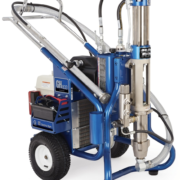Fireproofing Pump Selection Guide
In process terminals, power plants, petrochemical plants, refineries, and other locations where the chance of fire is high, various standards and codes suggest the company or licensor implement fireproofing. For this purpose, structures and equipment are fireproofed to a specific height or the entire unit per the required guidelines. Within locations that require fireproofing, there can be difficult-to-reach areas that require patching, so a smaller fireproofing pump is the best option. A fireproofing pump is a ready-to-go system with a top-mounted air compressor to spray the fireproofing material out of the gun.
Before purchasing a fireproofing pump, it is important to understand the basics of fireproofing and the related pump.
What is Fireproofing?
Fireproofing offers varied materials, equipment, and structures resistance to fire so that during an accidental fire, critical structures can continue to operate until the fire is maintained. Fireproofing is applying products over those units which minimize fire escalation so operators can act against the accident.
Types
In most industrial facilities, fireproofing is a requirement to secure insurance. Therefore, the process is split into two groups: active and passive. Active fireproofing requires human intervention to apply the fireproofing system. Passive fireproofing is designed and planned using specific fireproof materials including cementitious, intumescent, and firestop.
Cementitious
Cementitious fireproofing is a gypsum-based, plaster-like coating that appears like white stucco once dried. This coating type is sprayed on structural surfaces to keep the girders and beams under 540C during a fire, which is the point at which steel will bend.
Intumescent
Intumescent paints expand and create a heat resistant barrier when heated. This coating contains sodium silicate which helps the material to thicken, absorb air, and create a layer of improved insulation. Intumescent fireproofing coatings are used on valves, tanks, and pipes.
Firestop
Firestop fireproofing seals all joints and openings on walls and floors with a fire-resistant rated material. Fire dampers fill electrical wiring trays, pipe hole cuts, and ductwork holes.
Materials
U.S. standards and codes don’t provide direction as to the materials required for fireproofing other than it must be corrosion-resistant and durable. However, standard industry practice utilizes the following fireproofing materials for different applications, including:
- Carboguard 890 or 1340
- Carboline 139
- Carbomastic 801
- Cementitious plasters
- Concrete
- Fibrous plasters containing ceramic or mineral wood fibers
- Gypsum plasters
- Intumescent coatings
- Mesh
- Pyrocrete 241
- Thinners #2, 25, 33, or 76
Methods
The most agreed-upon application methods for fireproofing equipment with a pump include:
- Equipment surface preparation.
- Primer application of up to 65-75 microns.
- Fix the nut by tack welding to maintain tie mesh.
- Apply Pyrocrete 241.
- Apply two coats of epoxy paints and validate the paint and fireproofing material thickness.
- Double-checked and released by the head engineer.
When applying structural items, a small fireproofing pump is used for difficult-to-reach places or larger units to apply fireproofing across a wider area.
Fireproofing Pump Buying Guide
If you’re purchasing a fireproofing pump for the first time, upgrading your current unit, or adding additional equipment to inventory, there are a variety of available pump solutions. Therefore, it is important to consider the following points from this fireproofing pump buying guide:
Determine the Right Size for the Job
Unfortunately, there is no one-size-fits-all approach for fireproofing pumps, so it is crucial to understand and discuss the work expectations and scope with your pump manufacturer before purchasing a unit. Fireproofing pumps range from portable handheld units to large high-pressure units that can spray an entire large warehouse. A pump that is too small for your needs equates to poor efficiency and low productivity and an oversized pump is a waste of money which lowers your ROI and profits. Furthermore, the correct pump sizing means you also have the best accessories for the job.
Establish the Right Power Requirements
Power requirements for different pumps are an important consideration when calculating upfront and continual costs. Specific power requirements are based on the size of the area needed for fireproofing. For instance, a smaller pump unit for the patchwork of a beam will consume significantly less power than a tall, multistory building. In the latter case, some buyers will rent a generator to move materials and equipment closer to the application site for improved efficiency and cost-effectiveness. This topic must be discussed with your fireproofing equipment seller.
Match Your Fireproofing Materials
Depending on the need of your site, certain high-density materials require more powerful pumps because of the thickness and consistency. Low and medium-density materials can be used with most pumps without concern. Therefore, it is critical to consider the materials you currently use and may need in the future when discussing different pumps with your retailer. You want to ensure the pump can consistently and reliably deliver the materials you utilize on the job.
Understand Distance and Height Specifications
Before making a pump purchase, the distance and height specifications for the job are the most significant discussion points with a sales representative. In addition to knowing how far and high fireproofing materials need to be pumped, considerations around material types, ease of use, meeting bid specs, and pump technology will be the key to making the smartest purchase decision.
Generally, sales representatives will recommend more powerful pumps because they pay for themselves regarding productivity. For instance, consistently having to re-position and reset the equipment because it isn’t powerful enough from the distance and height required is a waste of resources, money, and time that can be avoided with proper pump selection.
Fireproofing is not only a requirement for insurance but also keeps your employees safe and operations continuing without issue while the fire is exhausted. There are many considerations when researching the best pump to meet your needs but following this fireproofing pump buying guide will help you make the right decision faster!




